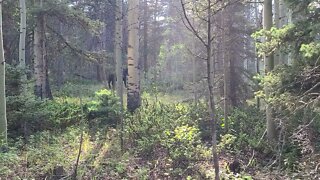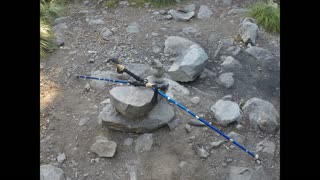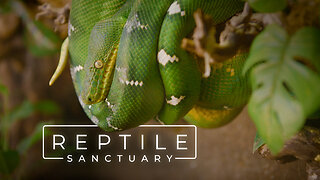Cradle Mountain Hike (Tasmania, Australia)
Awesome Hiking at Cradle Mountain, Tasmania (2 Hikes)
Cradle Mountain is a locality and mountain in the Central Highlands region of the Australian state of Tasmania. The mountain is situated in the Cradle Mountain-Lake St Clair National Park.
At 1,545 metres (5,069 ft) above sea level, it is the sixth-highest mountain in Tasmania.[1]
The locality of Cradle Mountain is a rural locality in the local government areas of Meander Valley, Kentish and West Coast in the Launceston and North-west and west local government regions of Tasmania. The locality is about 109 kilometres (68 mi) west of the town of Westbury. The 2016 census has a population of 66 for the state suburb of Cradle Mountain. Cradle Mountain was gazetted as a locality in 1966. Cradle Mountain (the mountain) occupies a small area in the north-west of the locality, which occupies the northern half of Cradle Mountain-Lake St Clair National Park. Route C132 (Cradle Mountain Road / Dove Lake Road) enters from the north and runs south to Dove Lake, where it ends.
The area is covered in a variety of alpine and sub-alpine vegetation, including the colourful deciduous beech, itself an anomaly given that most Australian native flora is evergreen. Alpine coral fern and button grass dominate the alpine wet sedgelands near the mountain summit. Stands of Tasmanian snow gum can be found at slightly lower elevations alongside Tasmanian eyebright, scoparia heath, mountain rocket, waratah, Cheshunt pine and pencil pine. Within the valleys surrounding the mountain, species such as myrtle beech, pandani, sassafras, King Billy pine and celery top pine form thick temperate rainforest with dense, mossy undergrowth.
Fungi are also a part of the park's biodiversity. While the Management Plan from 1999 for Cradle Mountain-Lake St Clair National Park only mentions fungi in the context of their destructive effects (Phytophthora cinnamomi and Chalara australis), the park has a variety of fungi that perform beneficial ecological roles. Parasitic fungi—often regarded negatively—are a vital part of healthy ecosystems, regulating ecosystem functions.
As primary recyclers of organic matter, saprobic fungi break down fallen branches and leaf litter, making vital nutrients available to other organisms. Other fungi form symbiotic relationships with other organisms. Although rarely acknowledged, the great majority of plants in Cradle Mountain-Lake St Clair National Park (and, indeed, in the world) form mutually beneficial mycorrhizal relationships with fungi.
Given the diversity of plants, specialist habitats and micro-climates in the park, a diversity of fungi, including lichens, is also expected to occur. Several hundred species have already been recorded by field naturalists and interested individuals and can be found in the Atlas of Living Australia.
Despite their essential roles in underpinning terrestrial ecosystems, fungi are barely recognised as a vital part of Australia's biodiversity. Although Australia has national and state level biodiversity conservation strategies and has ratified international conventions, most overlook fungi, including Tasmania's Natural Heritage Strategy, which only makes one generic reference to fungi.
One of the more a conspicuous species found in the wetter parts of the park is the strawberry bracket fungus (Tyromyces pulcherrimus). It grows on myrtle beech (Nothofagus cunninghammii) and snow gums. The Australian citizen-science organisation, Fungimap is documenting and mapping the distribution of fungi including those that occur in national parks
Badlands South Dakota
Mount Rainier
Wonderland Trail
Hamilton Mountain
Beacon Rock
Great Lake
Tasmania, Australia Hiking
Ocean Beach Hike
Weldborough Pass Rainforest
Barmeyer Loop
Missoula, Montana
Mount Wellington
The Nut Stanley, Tasmania
South Cape
Eagle
Columbia River Gorge
Wineglass Bay
Silver Star Mountain
Cradle Mountain
Camelback Mountain
Arizona
Washington
Pinnacle Peak
Mt. Rainier
#VideoStudios
Video Studios
One News Page
#OneNewsPage
Shorts
Hiking shirt Sleeveless
1 wool or polyester sweater
garbage bags
straps
extra stuff sacks
space blanket
Bowl
spoon
Cup & Plate
Jumper Cables
Elevation
Altitude
Valley
Forest
Knife
Moleskin
Tennis Ball
Rain Gear
Stuff sack
Rain Jacket
Rain Pants
Pack cover
tent sleep items
Pillow
Pair of socks
Hat
Gloves
Long Johns
Long sleeve shirt
extra underwear
camelback
Water Filter purifying tablets
Powder Gatorade
Vitamins
Towel
Toothbrush
Toothpaste
Chap stick
Soap
Bugs
sunscreen
Headlamp
Whistle
Sunglasses
Lighter
Matches
Supplies
Pack
Tent
Sleeping Bag
Sleeping Pad
Boots or Hiking Tennis shoes
Sit Pad
Hiking stick
Map
Sandals
All The Food
Water bottle
Glaciers
Rivers
Mountains
Dust
Dirt
Trail
Track
Hike
Backpack
Overnight
Rope Food
-
 1:26
1:26
Patriot663
2 years agoWolf Mountain Hike
31 -
 0:18
0:18
American Made Adventures
2 years agoRandom Cow Discovered On Mountain Hike
37 -
 3:01
3:01
RixSix
2 years agoWildcat Mountain
78 -
 8:02:15
8:02:15
SNEAKO
13 hours agoFRESH EDATE, SPECIAL GUEST, BIG STREAM
161K94 -
 8:04:33
8:04:33
Fed Reacts
15 hours agoFed Explains The Disappearance of Madeleine Mccann & Overwatch Raging!
89K55 -
 2:24:44
2:24:44
vivafrei
1 day agoEp. 211: Trump Trial, Jack Smith, Tyson Loses, Ukraine, Russia V. Google & MORE!
191K414 -
 3:02:10
3:02:10
Due Dissidence
1 day agoSeinfeld Show INTERRUPTED by Protests, Police CRACK DOWN on Nakba March, Cardi B TRASHES Biden
107K88 -
 15:48
15:48
PARAGRAPHIC
1 day agoThe Largest Reptile Sanctuary in the United States | PARAGRAPHIC
47.3K23 -
 27:45
27:45
Adam Does Movies
20 hours ago'The Strangers: Chapter 1' Is Hot Garbage - SPOILERS!
48.4K15 -
 8:33
8:33
MichaelBisping
1 day agoBISPING Reacts: "Tyson Fury COULDN'T Keep The Pace!" | Tyson Fury vs Oleksandr Usyk Reaction
55.9K23